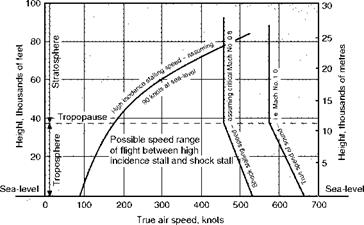Height and speed range
It was explained in Chapter 7 that for a piston-engined aircraft owing to limitations of power the speed range of an aircraft narrows with height, until, at the absolute ceiling, there is only one possible speed of flight. This speed, however, was not the stalling speed, but rather the speed of best endurance, and the absolute ceiling was simply a question of engine power; for a given aircraft, the greater the power supplied, the higher would be the ceiling.
Now, however, with almost unlimited thrust available in the form of jets or rockets, or eventually perhaps atomic energy, there is an altogether new aspect of the limitation of height at which an aircraft can fly without stalling – one way or the other. For the true speed of the high incidence stall will increase with height, while the true speed of the shock stall will fall from sea-level to the base of the stratosphere, and then remain constant. The result, assuming a sea-level stalling speed (high incidence) of 46 m/s and a critical Mach Number of 0.8, is shown in Fig. 11.8, the shaded portions being the regions in which flight is not possible without stalling. It will be evident that if this aeroplane is to avoid both kinds of stall, it cannot fly above 23 000 m, whatever the power available, while if it flies at 23 000 m, it can only fly at the stalling speed. If it flies any slower it will stall (high incidence), and if it flies any faster it will stall (shock). Surely a modern interpretation of being between the devil and the deep sea! Figure 11.9 shows exactly the same thing from the point of view of indicated speeds. Thus, quite apart from engine power, there is a limitation to the height of subsonic flight, and a narrowing of the speed range as the limiting height is approached.
This curious coming together of the two stalls will occur at considerably lower heights during manoeuvres, which will cause the high incidence stalling speed to increase, and the shock stalling speed to decrease. The figures in Table 11.5 are quite reasonable for 40 000 ft (say 12 000 m).
|
Table 11.5 Effect of altitude on stalling speeds
|
|
True air speed, metres per second 0 50 100 150 200 250 300 350
|
Fig 11.8 Subsonic speed range of flight – true speeds
One must always be careful in interpreting results of this kind. The above discussion must not be taken to imply that all aircraft are limited by shock stall or buffet at the maximum speed. This will be true for aircraft designed for economical cruise at transonic speed (as are most commercial airliners) but clearly many aircraft are designed to pass through the transonic speed range and cruise at supersonic speed – but more of that in the next chapter.
|
Indicated air speed, metres per second
|
Fig 11.9 Subsonic speed range of flight – indicated speeds
Before we move on to supersonic flow, though, we will spend a little time examining the ways in which knowledge of transonic flows was acquired by experiment and how this knowledge is used in the design of aircraft which operate at transonic speeds.













